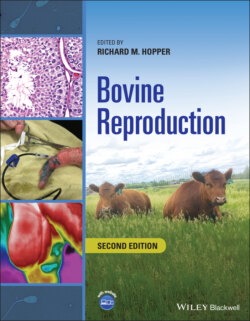Читать книгу Bovine Reproduction - Группа авторов - Страница 34
Historical Perspective
ОглавлениеIt has been evident for many centuries that the testes exercise control over the characteristics of the male body. The results of castration in domestic animals and human males made this very clear, but provided no clues as to the mechanism of control. Pritchard [1] noted from Assyrian records dating some 15 centuries BCE that the castration of men was used as punishment for sexual offenders, which suggests that the effect of castration on fertility and behavior was recognized at that time. Knowledge of the effects of castration of livestock dates back to the Neolithic Age (c. 7000 BCE) when animals were first thought to have been domesticated [2]. The effects of castration were understood by Aristotle (~300 BCE) who provided very detailed and clear descriptions of testicular anatomy and function [3]. It was not until the seventeenth century that a detailed account of testicular and penile anatomy was presented by Regnier de Graaf [4] in a treatise on the male reproductive organs. De Graaf indicated the existence of the seminiferous tubules and suggested that the production of the fertile portion of the semen occurred in the testes. The first microscopic examination of the testes was undertaken by Antonie van Leeuwenhoek in 1667 where he demonstrated and reported the presence of germ cells in the seminal fluid [5].
Detailed study of the testis began in the mid‐nineteenth century. In 1840, Albert von Köllicker discovered that spermatozoa develop from cells residing in the testicular (seminiferous) tubules. This major discovery was followed by Franz Leydig's [6] description of the microscopic characteristics of the interstitial cells. Later, Enrico Sertoli [7], an Italian scientist, correctly described the columnar cells running from the basement membrane to the lumen of the tubuli seminiferi contorti (seminiferous tubules) of the testes, and Anton von Ebner is credited with introducing the concept of the symbiotic relationship between Sertoli cells and the developing germinal cells [8, 9].
The first clear demonstration that the testes are involved in an endocrine role was made by Arnold Berthold in 1849, while studying the testes of the rooster. He concluded that the regulation of male characteristics was brought about by way of blood‐borne factors. The most compelling evidence for an endocrine function of the testes being associated with Leydig cells was presented by two French scientists, Bouin and Ancel in 1903. They reported that ligation of the vas deferens in dogs, rabbits, and guinea pigs was followed by degeneration of the seminiferous tubules, but no castration effects were observed and no degenerative changes of the interstitial cells, and thus it was concluded that internal secretions of the testes were synthesized by the Leydig cells [10]. By the mid‐1930s it was clear that the male hormone emanating from the testes was testosterone [11] and that the function of the testes was controlled by pituitary hormones [12, 13]. Smith [12] demonstrated that the pituitary gland must secrete substances (now known as gonadotropins) responsible for the stimulation of testicular growth and maintenance of function in the rat. Greep et al. [14] restored Leydig cell function in hypophysectomized rats with crude preparations of LH and reestablished the male secondary sex characteristics. Further evidence was elucidated in favor of a steroid secretory function for Leydig cells from a study on postnatal development in bulls where changes in testicular androgen levels paralleled the differentiation of these cells [15]. Using cell culture techniques, Steinberger et al. [16] provided direct evidence that the Leydig cells are the primary source of steroid hormone synthesis in the testes. Later, it became apparent that the Leydig cells are essential for providing the androgenic stimuli that are required for the maintenance of spermatogenesis in the germinal epithelium [16, 17].
